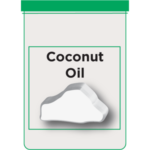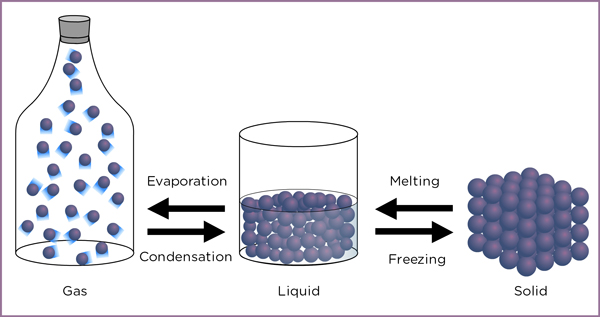What’s the Matter?
What is matter?
Matter is anything that takes up space and has mass. Sometimes you can see matter easily and other times, not so much. Your favorite toy is matter but so is the air you breathe. So how are they both matter? You can see one but not the other.
There are three main states of matter: solids, liquids, gases.
- Solids have a definite shape and volume and are made of molecules that are close together. Examples are ice or butter.
- Liquids have a definite volume but do not have a shape of their own; they take the shape of the container they are in. Liquids can also be poured. Examples are water or honey.
- Gases do not have a fixed shape or volume. Instead, they take the shape of their container and float about freely. An example is water vapor.
Water has the ability to change back and forth between all three states of matter. Water as we know it is a liquid. If this liquid is heated, it can change to a gas known as water vapor. We often see this water vapor as steam. Water that is put into a freezer changes to a solid, ice! Ice and water vapor can both turn back into water, just change their temperature. So, what is temperature? Temperature is measured with a thermometer and tells how hot or cold something is. Changing an objects’ temperature can often change its state of matter. Let’s explore this idea!
The Experiment
You probably have had many experiences with things melting before. Think about it; your favorite ice cream flavor dripping off the cone, ice in a drink “disappearing”, wax in a burning candle, or even the unfortunate melted crayon, just to name a few. Coconut oil, much like butter, is a solid at room temperature. Find out what happens to coconut oil when its temperature changes. This experiment works best if you keep track of time. (Suggestion: Invite a sibling or parent to be your timekeeper.) *Do not use coconut oil if you are allergic. A good substitute is butter.
Materials
Coconut oil
(Put the coconut oil in the refrigerator until you are ready to do the experiment.)

Container with lid to store oil

Directions
STEP 1
Squeeze half of the coconut oil in the palm of your hand. Keep track of time for one minute. Use a timer or clock if possible but counting to 60 will be fine.
STEP 2
Observe what happens after one minute and record your observations on the record sheet. (You should still be keeping track of time.)
STEP 3
Make observations each minute until the coconut oil is completely melted and changed to a liquid. Record how long it took to melt completely.
STEP 4
Pour as much of the oil from your hand in the storage container provided.
STEP 5
Use the other half of the coconut oil and place it in the direct sunlight. Wait for a sunny day if it is dark or cloudy. Use a timer or clock if possible but counting to 60 will be fine.
STEP 6
Observe what happens after one minute and record your observations on the record sheet. (You should still be keeping track of time.)
STEP 7
Make observations each minute until the coconut oil is completely melted and changed to a liquid. Record how long it took to melt completely.
STEP 8
Pour as much of the oil back into the storage container.
STEP 9
Observe the coconut oil in the storage container at room temperature. Determine how long it takes to return to a solid and record your observations on the record sheet.
Dinner Talk
- What was the coolest part of the experiment? Why?
- Does coconut oil melt?
- What happens to coconut oil when the heat is added? What happens when the heat is removed?
- Once coconut oil changes to a liquid, can it change back to a solid?
- Did the oil melt faster in your hand or in the sun? What does this tell you about those temperatures?
- Did the color or smell of the oil change as it changed from a liquid to a solid or a solid to a liquid?
Extra Enrichment
- Write about it: Record your observations on your record sheet. Write a few sentences about your discoveries.
- Try putting the coconut oil in the freezer overnight or for a few hours. Does it change?
- Conduct the same experiment with different materials such as butter, ice cream, wax, etc.




